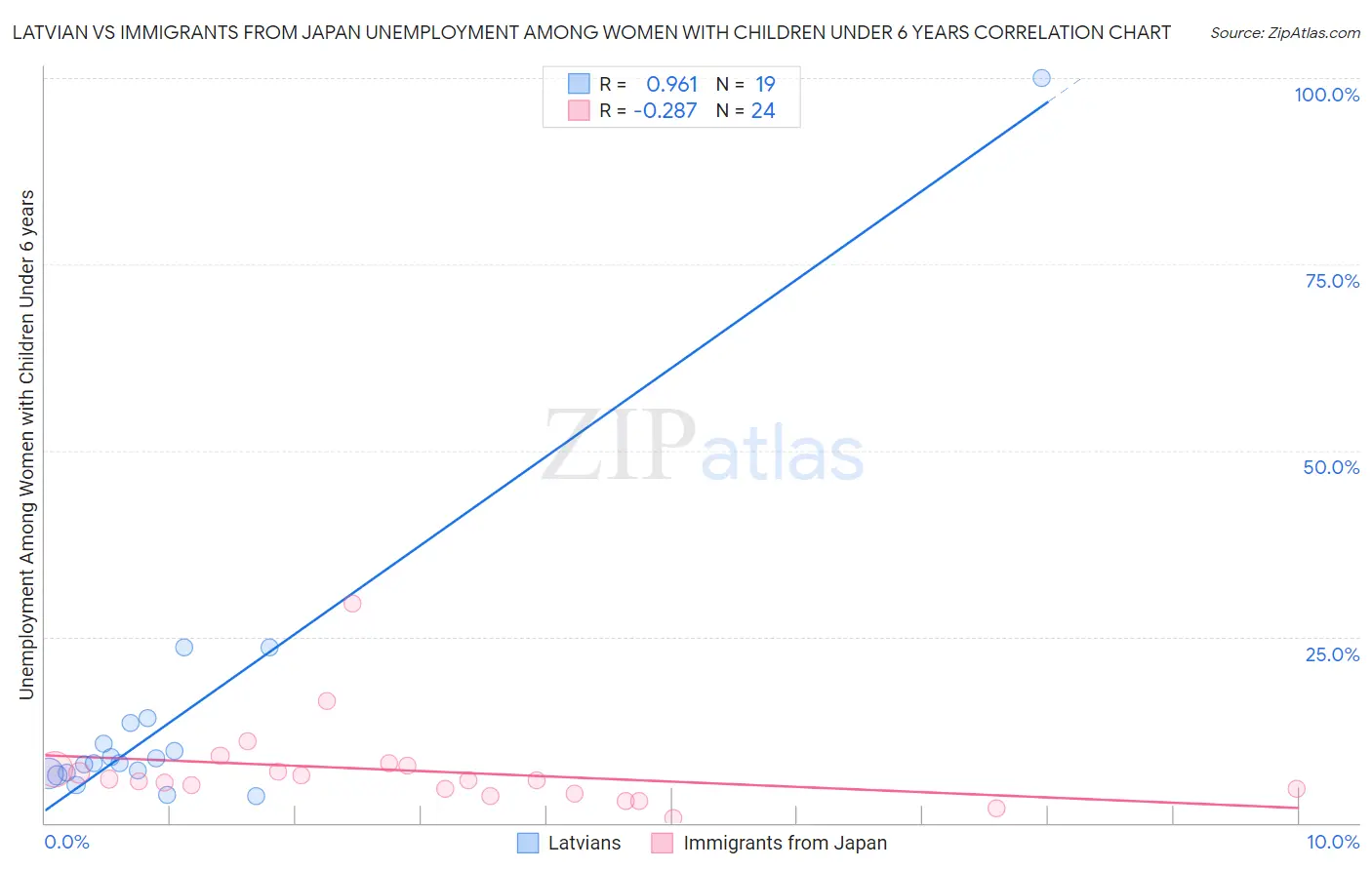Latvian vs Immigrants from Japan Unemployment Among Women with Children Under 6 years
COMPARE
Latvian
Immigrants from Japan
Unemployment Among Women with Children Under 6 years
Unemployment Among Women with Children Under 6 years Comparison
Latvians
Immigrants from Japan
6.8%
UNEMPLOYMENT AMONG WOMEN WITH CHILDREN UNDER 6 YEARS
99.9/ 100
METRIC RATING
46th/ 347
METRIC RANK
6.5%
UNEMPLOYMENT AMONG WOMEN WITH CHILDREN UNDER 6 YEARS
100.0/ 100
METRIC RATING
27th/ 347
METRIC RANK
Latvian vs Immigrants from Japan Unemployment Among Women with Children Under 6 years Correlation Chart
The statistical analysis conducted on geographies consisting of 177,379,958 people shows a perfect positive correlation between the proportion of Latvians and unemployment rate among women with children under the age of 6 in the United States with a correlation coefficient (R) of 0.961 and weighted average of 6.8%. Similarly, the statistical analysis conducted on geographies consisting of 268,694,372 people shows a weak negative correlation between the proportion of Immigrants from Japan and unemployment rate among women with children under the age of 6 in the United States with a correlation coefficient (R) of -0.287 and weighted average of 6.5%, a difference of 3.4%.

Unemployment Among Women with Children Under 6 years Correlation Summary
| Measurement | Latvian | Immigrants from Japan |
| Minimum | 3.6% | 0.70% |
| Maximum | 100.0% | 29.5% |
| Range | 96.4% | 28.8% |
| Mean | 14.5% | 7.0% |
| Median | 8.0% | 5.7% |
| Interquartile 25% (IQ1) | 6.7% | 4.3% |
| Interquartile 75% (IQ3) | 13.4% | 7.4% |
| Interquartile Range (IQR) | 6.7% | 3.2% |
| Standard Deviation (Sample) | 21.4% | 5.7% |
| Standard Deviation (Population) | 20.9% | 5.6% |
Demographics Similar to Latvians and Immigrants from Japan by Unemployment Among Women with Children Under 6 years
In terms of unemployment among women with children under 6 years, the demographic groups most similar to Latvians are Immigrants from Australia (6.8%, a difference of 0.24%), Iranian (6.7%, a difference of 0.30%), Bhutanese (6.7%, a difference of 0.85%), Immigrants from Cuba (6.7%, a difference of 1.1%), and Immigrants from Indonesia (6.7%, a difference of 1.2%). Similarly, the demographic groups most similar to Immigrants from Japan are Immigrants from Israel (6.5%, a difference of 0.020%), Cypriot (6.5%, a difference of 0.10%), Immigrants from Sweden (6.6%, a difference of 0.28%), Immigrants from Belarus (6.6%, a difference of 0.60%), and Immigrants from Moldova (6.6%, a difference of 0.89%).
| Demographics | Rating | Rank | Unemployment Among Women with Children Under 6 years |
| Cypriots | 100.0 /100 | #26 | Exceptional 6.5% |
| Immigrants | Japan | 100.0 /100 | #27 | Exceptional 6.5% |
| Immigrants | Israel | 100.0 /100 | #28 | Exceptional 6.5% |
| Immigrants | Sweden | 100.0 /100 | #29 | Exceptional 6.6% |
| Immigrants | Belarus | 100.0 /100 | #30 | Exceptional 6.6% |
| Immigrants | Moldova | 100.0 /100 | #31 | Exceptional 6.6% |
| Tsimshian | 100.0 /100 | #32 | Exceptional 6.6% |
| Immigrants | Vietnam | 100.0 /100 | #33 | Exceptional 6.6% |
| Immigrants | South Central Asia | 100.0 /100 | #34 | Exceptional 6.6% |
| Yakama | 100.0 /100 | #35 | Exceptional 6.6% |
| Luxembourgers | 100.0 /100 | #36 | Exceptional 6.6% |
| Sri Lankans | 100.0 /100 | #37 | Exceptional 6.6% |
| Hmong | 100.0 /100 | #38 | Exceptional 6.7% |
| Immigrants | Russia | 100.0 /100 | #39 | Exceptional 6.7% |
| Asians | 100.0 /100 | #40 | Exceptional 6.7% |
| Immigrants | Indonesia | 99.9 /100 | #41 | Exceptional 6.7% |
| Immigrants | Cuba | 99.9 /100 | #42 | Exceptional 6.7% |
| Bhutanese | 99.9 /100 | #43 | Exceptional 6.7% |
| Iranians | 99.9 /100 | #44 | Exceptional 6.7% |
| Immigrants | Australia | 99.9 /100 | #45 | Exceptional 6.8% |
| Latvians | 99.9 /100 | #46 | Exceptional 6.8% |